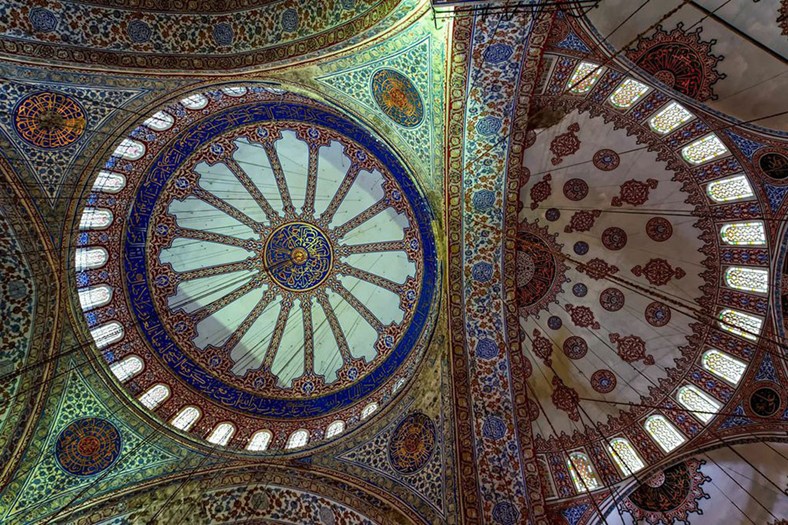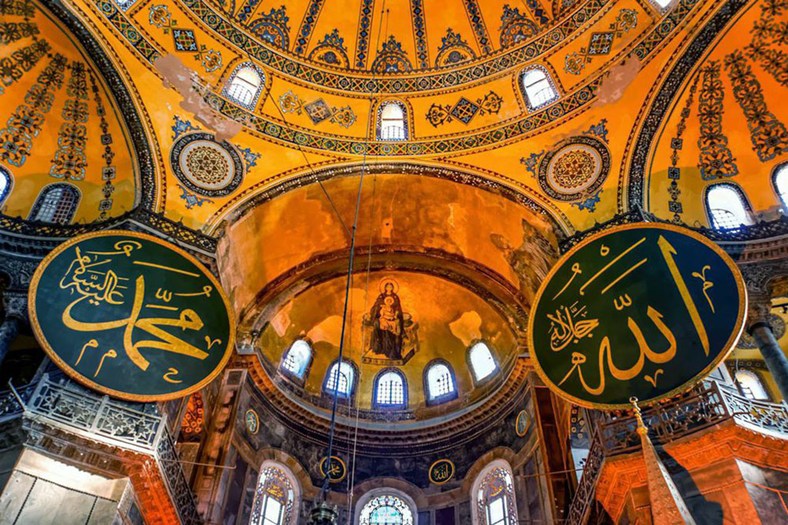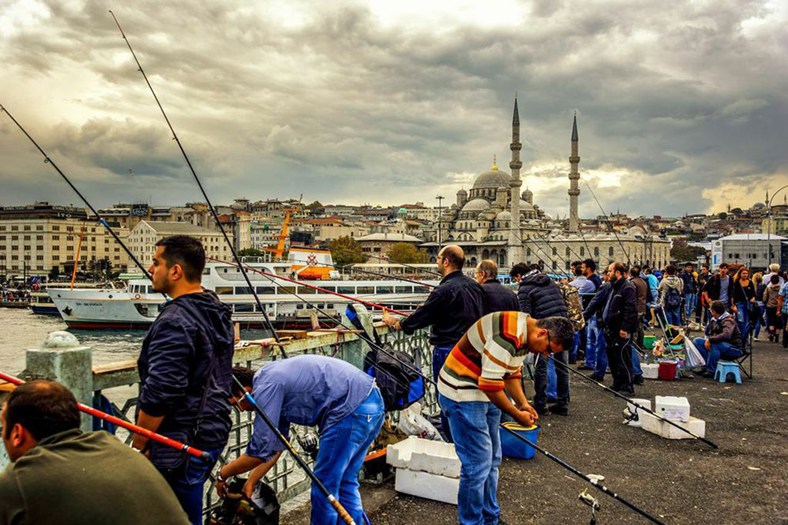ISTANBUL - Bahar dumps pales of soapy, warm water over my body, and limb by limb she scrubs me down. I’m lying in my birthday suit underneath the dome of a Turkish hammam. The heat and the methodical sound of water hitting the stone floor are lulling me to sleep. And when I open my eyes in between rinsing, I’m surrounded by foggy steam and the outline of other women, barely clad as they’re bathed, too.
After four days of touring the hectic, narrow streets of Istanbul, the tranquility of the hammam is the perfect pit stop for tired feet.
Bahar makes me lie on my stomach and lathers my back. She manoeuvers me upright, and hugs me between her thighs so she can massage my scalp, and delicately wash my face. With an exfoliating glove, she strips away dirt and dead skin cells. I emerge from the sauna with skin so soft, it rivals a newborn baby’s. I feel revitalized, awake and fresh — exactly the sentiment I’ve been feeling during my time soaking up Turkey’s largest city.
I didn’t know what to expect from Istanbul — it’s known for its gorgeous sights, the Hagia Sophia and the Blue Mosque, its Grand Bazaar that stretches across dozens of blocks, and Topkapi Palace where Ottoman sultans once ruled much of the world for hundreds of years.
But I learn quickly that the city’s present-day culture is as thick as its illustrious history. It has Greek, Roman and Ottoman influences, and don’t forget: Istanbul sits in both Europe and Asia, with the Bosphorus Strait cutting through the city and the continents. Turkey is also the only Muslim state that’s secular — Catholics, Jews and other faiths also call Istanbul home.
What you get from that kind of diversity is a sophisticated city made of minarets and skyscrapers; local markets that are just as ubiquitous as coffee shop chains; and a daily call to prayer alongside bars and thriving nightlife. It’s a mishmash of experiences that shakes your senses.
I felt that awakening at the Hagia Sophia. The pink exterior is deceptive and its backstory is just as misleading. It’s changed hands from Christian church, Muslim mosque and it’s now a museum. I don’t know what to expect, but once I step in, I’m awestruck. I get tired of the endless number of churches in Europe but the Hagia Sophia is in a league of its own.
It’s pink and coral façade is fading into shades of grey but once inside the cavernous space — it’s allegedly big enough to house Paris’ Notre Dame Cathedral — I feel chills. I’m surrounded by golden walls, dramatic stained glass windows and dozens of arches. You can see its Catholic origins and its Islamic transformation — there are mosaics and frescoes of the Virgin Mary and Jesus, scripture from the Quran written in beautiful calligraphy, and four minarets in each corner of the mosque outside. The air is thick with calm and the way the light falls into the hollow room is haunting — I’m not the religious type but I feel this is a place to connect with a higher power.


Above: The churches and mosques in Istanbul are truly spectacular.
In the early afternoon, the call to prayer while standing between the Hagia Sophia and the Blue Mosque is a moment I won’t forget. It begins with a muezzin’s call from a single minaret from the Blue Mosque and seconds later, a response echoes from the Hagia Sophia, like a conversation. The hymns are beautiful, a single line sung in a melody that’s humbling and takes you to another world I’m so happy to encounter. The bustling city is silent as the two mosques, among thousands of others scattered across the city, broadcast their calls to prayer. You don’t have to pray in the mosque but it’s imperative for Muslims to pray five times a day, whether it’s in their homes, at work or in a mosque, my friend Huseyin tells me.
We leave the Sultanahmet neighbourhood that’s packed with ancient sights — the Hippodrome, Blue Mosque, Hagia Sophia and the Basilica Cistern are all minutes away from each other — for a sunset walk along the Galata Bridge. It’s the perfect time to watch the hundreds of fishermen hanging their rods over the bridge’s edge, trying their luck with the abundance of seafood in the Bosphorus.
The men are dressed in windbreakers, and each one has his own set up: lawn chair, with a rucksack on its side, Styrofoam boxes filled with water, a home ready to house their catches of the day. Small plastic cups hold their bait.
And when the men cast their bait, they extend their rods far behind them and whip them forward, launching their lines far out into the dark waters of the Bosphorus. It goes on like this for kilometres, the sun warming my face, the smell of the salty seawater, and the endless rows of fishermen.

Above: From the Galata Bridge, locals fish for their dinners.
Some are proud to show off their loot to potential buyers. As people walk by, they take their catch and twist the gills to show how ruby red and fresh the fish are.
The fishermen aren’t the only hustlers. In the thick of it all, there are vendors carrying baskets of simit — the Turkish equivalent to a sesame bagel – held precariously on top of their heads. Others push carts filled with sahlep, a warm cinnamon and milk drink, or roasted corn and chestnuts and my personal favourite, Turkish ice cream. The dessert isn’t like its typical melty counterpart, dondurma is sticky and gooey. And just four Turkish lira buys me a multicolour scoop of all the flavours.
I decide it’s time to head to the Grand Bazaar to load up on more sweets, particularly Turkish Delight. The bazaar has more than 1,000 shops in almost 60 streets. It’s easy to get overwhelmed in the rows of shop peddling pashminas, leather goods, Turkish tea sets and hookahs.
Huseyin takes me to his favourite Turkish Delight stall — there’s rosewater, pomegranate, pistachio, chocolate, and walnuts. We can’t stop eating the samples — turns out, all this shopping and haggling is building up our appetite! After handpicking a box of the candy, we decide it’s time for dinner.
And as the sights didn’t disappoint, our meals don’t either. In a cozy table at family-run restaurant called Erhan, I’m digging into a piping hot moussaka. It’s in a clay pot, bubbling over with cheese, hearty chunks of spiced lamb, eggplant, red peppers, zucchini, onions and mushrooms. It’s delicious on its own, and even better when slathered on top of rice and potatoes.


Above: The markets of Istanbul are exciting and colourful.
Then there’s hunkar begendi, the dish I can’t get enough of — lamb on a creamy eggplant puree. And Iskender Kebab, shaved beef doused in spicy tomato sauce with shreds of pita soaking up the meaty juices. And bites of burek, crispy baked phyllo pastry packed with cheese and spinach.
The sights, experiences, cuisine ... I can’t get enough of Istanbul. My belly’s full and my mind is wading in all that I’ve learned about the city, but I’m already looking forward to my next visit.
About the Author
Carmen Chai is an award-winning journalist who's lived and reported from major cities like Vancouver, Toronto, London and Paris. It's safe to say that Carmen has a serious case of wanderlust. She's travelled to more than 25 countries and for a plethora of reasons: hiking along Italy's Amalfi Coast, gorging on street food in Bangkok and getting lost in Istanbul's bustling streets. Along with travel writing, Carmen has reported on crime, federal politics and breaking news for major Canadian publications, including the Toronto Star.